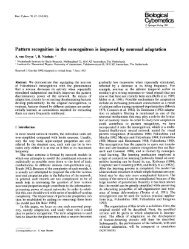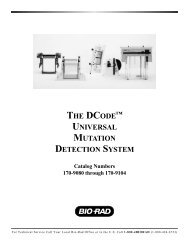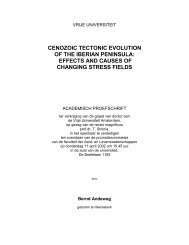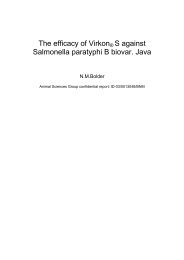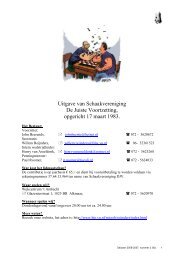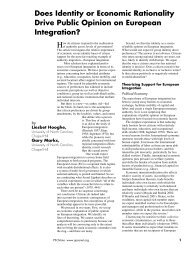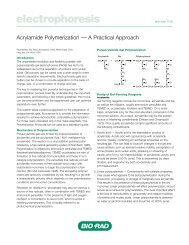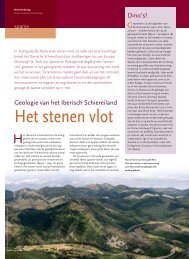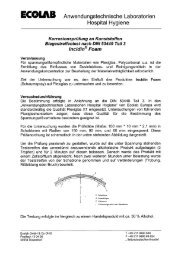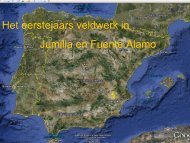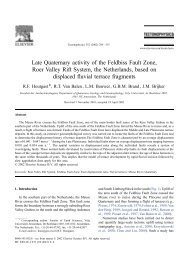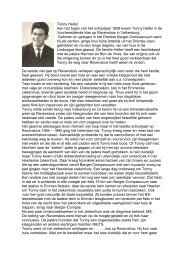5 NATURAL ABUNDANCE OF THE STABLE ISOTOPES ... - Falw.vu
5 NATURAL ABUNDANCE OF THE STABLE ISOTOPES ... - Falw.vu
5 NATURAL ABUNDANCE OF THE STABLE ISOTOPES ... - Falw.vu
Create successful ePaper yourself
Turn your PDF publications into a flip-book with our unique Google optimized e-Paper software.
7 <strong>NATURAL</strong> <strong>ABUNDANCE</strong> <strong>OF</strong> <strong>THE</strong> <strong>STABLE</strong><strong>ISOTOPES</strong> <strong>OF</strong> C, O AND HThis chapter is concerned with the natural concentrations of the stable isotopes of hydrogen,carbon and oxygen, with particular attention paid to those compounds relevant in thehydrological cycle. For each isotope separately, we discuss the natural fractionation effects,internationally agreed definitions, standards, and reference materials, and variations in thenatural abundances.In order to help the reader to appreciate isotopic abundance values as they occur in nature,Fig.7.1 shows some actual isotope ratios and fractionations in a choice of equilibriumsystems. Surveys of some practical data of all isotopes concerned are given in the respectiveSections.2 R = 0.00014354H 2 O (vapour)18 R = 0.00198567H 2 O (vapour)2 v/l = 78.4‰18 v/l = 9.74‰H 2 O (liquid) at 20 o C2 R = 0.00015575H 2 O (liquid) at 20 o C18 R = 0.0020052013 R = 0.0111421CO 2 (gas)18 R = 0.00200520H 2 O (liquid) at 20 o C13 g/b = 8.46‰18 s/l = +30.42‰HCO 3 (bicarbonate) at 20 o C13 R = 0.0112372CaCO 3 (solid calcite)18 R = 0.00206620Fig.7.1Examples of isotope ratios of compounds in isotopic equilibrium and the respectiveisotope fractionations, as defined in Sect.3.3. As an example may serve the calculation of13 g/b as 13 g/b 1 with 13 g/b = 0.0111421/0.0112372 = 0.99154.89
Chapter 77.1 <strong>STABLE</strong> CARBON <strong>ISOTOPES</strong>Table 7.1The stable and radioactive isotopes of carbon: practical data for the natural abundance,properties, analytical techniques and standards. Further details are given in Sect.7.1 and8.1, and in Chapters 10 and 11.MS = mass spectrometry, PGC = proportional gas counting, LSS = liquid scintillationspectrometry, AMS = accelerator mass spectrometry12 C13 C14 Cstability stable stable radioactivenatural abundance 0.989 0.011 < 10 12natural specific activity< 0.25 Bq/gCdecay mode / daughter / 14 Nhalf-life (T 1/2 )decay constant ()max. energyabundance rangein hydrological cycle5730 a1.2110 4 /a = 1/8267 a 1156 keV30‰ 0 to 10 12reported as13 or 13 C14 A, 14 a, 14 , or 14 in ‰ dpm/gC, Bq/gC, %, or ‰instrument MS PGC, LSS, AMSanalytical medium CO 2 CO 2 , C 2 H 2 , CH 4 ,C 6 H 6 , graphiteusual standard deviation 0.03‰ 1‰ to 1% at natural levelinternational standard VPDB Oxalic acid: Ox1, Ox2with absolute value 0.0112372 13.56 dpm/gC7.1.1 <strong>THE</strong> <strong>NATURAL</strong> <strong>ABUNDANCE</strong>The chemical element carbon has two stable isotopes, 12 C and 13 C. Their abundance is about98.9% and 1.1%, so that the 13 C/ 12 C ratio is about 0.011 (Nier, 1950). As a result of severalfractionation processes, kinetic as well as equilibrium, the isotope ratio shows a naturalvariation of almost 100‰.90
Stable Isotopes of Hydrogen, Carbon and Oxygenatmospheric CO 2marine HCO 3marine carbonatemarine plantsmarine planktonland plants C 4 typeland plants C 3 typegroundwater HCO 3fresh-water carbonatewoodpeatcoaloilnatural gasbacterial CH 4animal bonediamond80 60 40 20 0 +2013 VPDB (‰)Fig.7.2General view of 13 C/ 12 C variations in natural compounds. The ranges are indicative forthe materials shown.Fig.7.2 presents a broad survey of natural abundances of various compounds, at the low- 13 Cend bacterial methane (marsh-gas), at the high end the bicarbonate fraction of groundwaterunder special conditions. In the carbonic acid system variations up to 30‰ are normallyobserved. Wider variations occur in systems in which carbon oxidation or reduction reactionstake place, such as the CO 2 (carbonate) CH 4 (methane) or the CO 2 (CH 2 O) x(carbohydrate) systems.7.1.2 CARBON ISOTOPE FRACTIONATIONSIt will later be shown that the presence of dissolved inorganic carbon (DIC) in sea-, ground-,and surface water presents the possibility of studying gas-water exchange processes and ofmeasuring water transport rates in oceans and in the ground. In connection with studyingthese phenomena, the stable and radioactive isotopes of carbon and their interactions pay animportant contribution, often together with the water chemistry.91
Chapter 7fractionation 13 (‰)40CaCO 3HCO 3s/bc/bCO 32-4-8CO 2 gg/ba/bCO 2 aq-12010203040temperature t (C)Fig.7.3Temperature-dependent equilibrium isotope fractionation for carbon isotopes of gaseousCO 2 (g), dissolved CO 2 (a), dissolved carbonate ions (c), and solid carbonate (s) withrespect to dissolved HCO 3 (b). The actual data and equations are given in Table 7.2.In nature equilibrium carbon isotope effects occur specifically between the phases CO 2 H 2 O H 2 CO 3 CaCO 3 . Values for the fractionations involved only depend on temperature and areobtained from laboratory experiments. A survey is presented in Fig.7.3 and Table 7.2.The kinetic fractionation of specific interest is that during carbon dioxide assimilation, i.e. theCO 2 uptake by plants. The relatively large fractionation (up to about 18‰) is comparable tothe effect observed during absorption of CO 2 by an alkaline solution. A quantitative estimateshows that the isotope effect as a result of diffusion of CO 2 through air can not explain thefractionation (Sect.3.5). The resulting value of 13 is 0.9956, so that only 4.4‰ of the totalassimilation fractionation in favour of 12 C can be explained by the diffusion. The remaining13.6‰, therefore, has to be found in the surface of the liquid phase and in the subsequentbiochemical process.92
Stable Isotopes of Hydrogen, Carbon and OxygenTable 7.2 Carbon isotope fractionation in the equilibrium system CO 2 HCO 3 CO 3 CaCO 3 ;13 y/x represents the fractionation of compound y relative to compound x. Values forintermediate temperatures may be calculated by linear interpolation (see also Fig.7.3).T = t (C) + 273.15 Kg = gaseous CO 2 , a = dissolved CO 2 , b = dissolved HCO 3 , c = dissolved CO 3 2 ions, s = solidcalcite.t13 g/b 1 )13 a/g 2 )13 a/b 3 )13 c/b 4 )13 s/b 5 )13 s/g 6 )(C)(‰)(‰)(‰)(‰)(‰)(‰)0 10.83 1.18 12.00 0.65 0.39 +10.555 10.20 1.16 11.35 0.60 0.11 +10.1910 9.60 1.13 10 72 0.54 + 0.15 + 9.8515 9.02 1.11 10.12 0.49 + 0.41 + 9.5220 8.46 1.09 9.54 0.44 + 0.66 + 9.2025 7.92 1.06 8.97 0.39 + 0.91 + 8.8630 7.39 1.04 8.42 0.34 + 1.14 + 8.6035 6.88 1.02 7.90 0.29 + 1.37 + 8.3140 6.39 1.00 7.39 0.25 + 1.59 + 8.031 ) Mook et al., 1974 : 13 g/b = 9483/T + 23.89‰ (7.1)2 ) Vogel et al., 1970 : 13 a/g = 373/T + 0.19‰ (7.2)3 ) From 1 ) and 2 ) : 13 a/b = 9866/T + 24.12‰ (7.3)4 ) Thode et al., 1965 and 1 ) : 13 c/b = 867/T + 2.52‰ (7.4)5 ) Our evaluation of the original data from Rubinson & Clayton, 1969and Emrich et al., 1970 : 13 s/b = 4232/T + 15.10‰ (7.5)6 ) From 1 ) and 5 ) : 13 s/g = + 5380/T 9.15‰ (7.6)Another kinetic process occurring in the soil is the bacterial decomposition of organic matterto form methane (CH 4 ). Here the largest fractionation amounts to about 55‰. In this processCO 2 is simultaneously produced with a fractionation of +25‰, resulting in a 13 value ofabout 0‰.A special problem is the kinetic fractionation during uptake and release of CO 2 by seawater.This fractionation is included in calculations on global 13 C modelling.First we have to emphasise that the difference in isotopic composition between, for instance,gaseous CO 2 and the dissolved inorganic carbon content of water can not be addressed byisotope fractionation between CO 2 and DIC.93
Stable Isotopes of Hydrogen, Carbon and Oxygenor in terms of values:1313T13a a / b b c c / b 13 a a / b c c / b DIC b(7.8)CCwhere the brackets indicate the respective concentrations, which are also denoted by a (acid),b (bicarbonate), and c (carbonate ions), so that a + b + c = C T . The values are given in Table7.2. The chemical fractions are quantitatively treated in Chapter 9.Originally 13 k values for the uptake of CO 2 by seawater of about 15‰ were assumed, basedon experimental results of CO 2 absorption by an alkaline solution (Baertschi, 1952).However, Siegenthaler & Münnich (1981) have reasoned that this effect does not apply to thedissolving action of seawater. Calculations by these authors as well as by Inoue & Sugimura(1985) and Wanninkhof (1985) have shown the kinetic fractionation during CO 2 uptake to be13 k (air sea) = 13 k (atm.CO 2 to CO 2 taken up) = 2.0 ± 0.2‰13T13This value was confirmed by experiments of the last author (2.4 ± 0.8‰).(We have toremind the reader that these 13 k values as well as those below are for kinetic fractionationsand do not refer to Table 7.2).The kinetic fractionation during CO 2 release by the ocean reported by Siegenthaler &Münnich (1981) needs a correction (Mook, 1986). By application of the most recentequilibrium fractionations of Table 7.2 the equilibrium fractionation ( 13 a/DIC ) for dissolvedCO 2 with respect to total dissolved carbon at 20 o C is 0.99055. This fractionation factor is alsodetermined by the chemical composition of seawater, which adds to the overall temperaturedependence.At 20 o C the respective relative concentrations in seawater at pH = 8.20 are: CO 2 (aq)/C T =0.006, HCO 3 /C T = 0.893 and CO 3 2 /C T = 0.102 where C T is the total inorganic carbonconcentration. By incorporation of the CO 2 + OH reaction (0.9995), the resulting 13 value is10.1 to 10.6‰, depending on whether the hydration of CO 2 to H 2 O is to be included.According to Inoue & Sugimura (1985) the value is about -10‰, so that we can conclude to afractionation of released CO 2 with respect to DIC of:13 k (sea air) = 13 k (DIC rel. to CO 2 released) = 10.3 ± 0.3‰Figure 7.4 represents a review of equilibrium and kinetic fractionations relative to gaseousCO 2 (left-hand scale) and the actual 13 values based on 13 (atm.CO 2 ) = 7.0‰ (right-handscale). It is obvious that the isotopic compositions of CO 2 released and taken up by the oceanare equal, as is required by the condition of stationary state of isotopic equilibrium betweenocean and atmosphere.95
Chapter 77.1.3 REPORTING 13 C VARIATIONS AND <strong>THE</strong> 13 C STANDARDAs described in Sect.4.1, isotopic compositions expressed as 13 values are related to those ofspecific reference materials. By international agreement PDB was used as the primary carbonreference (standard) material. PDB (Pee Dee Belemnite) was the carbonate from a certain(marine) belemnite found in the Cretaceous Pee Dee formation of North America. Thismaterial was the original standard sample used in the early days in Chicago and at CalTech,but has long been exhausted. The US National Bureau of Standards therefore distributedanother (marine) limestone of which 13 had been accurately established in relation to PDB.This first standard available to the community, Solenhofen limestone NBS20, was analysedby Craig (1957) and consecutively defined as:13 NBS20 / PDB = 1.06‰In this way the PDB scale was indirectly established. Meanwhile NBS20 is considered to beno longer reliable, probably because of improper storage, and has been replaced by anotherlimestone, NBS19, of which the 13 value has been compared by a number of laboratorieswith the previous standard.Based on this comparison an IAEA panel in 1983 (Gonfiantini, 1984) adopted this newstandard to define the new VPDB (Vienna PDB) scale as:13 NBS19 / VPDB = +1.95‰ (7.9)The absolute 13 C/ 12 C ratio of PDB was originally reported as 0.0112372 (Craig, 1957),whereas a slightly different value of 0.011183 ( 0.1‰) was reported by Zhang and Li(1987). The distinction between PDB and VPDB has been made for formal reasons, but thedifference is negligibly small (< 0.01‰).Henceforth all 13 values are reported relative to VPDB, unless stated otherwise.More details on measurement and calculation procedures are given in Chapter 11. A survey ofother reference samples is given in Table 11.2.7.1.4 SURVEY <strong>OF</strong> <strong>NATURAL</strong> 13 C VARIATIONSIn the other volumes certain aspects of natural 13 variations will be discussed in more detail.Here we will restrict ourselves to a general survey, particularly with regard to the hydrologicalcycle (Fig. 7.5).7.1.4.1 ATMOSPHERIC CO 2The least depleted atmospheric CO 2 had originally 13 values near 7‰. Since the 19thcentury this value has undergone relatively large changes. In general, high values areobserved in96
Stable Isotopes of Hydrogen, Carbon and Oxygen13 VPDB (‰)+ 5bicarbonatemarinecalcitefreshwaterbicarbonate calcite0exchange with atmosphere 5atmospheric CO 210groundwater HCO 325C5 C15C 4 plantsexchange with soil CO 220soil CO 22530C 3 plantscoaloil35natural gas (CH 4 )40Fig.7.5Schematic survey of 13 variations in nature, especially of compounds relevant in thehydrological cycle.97
Chapter 7oceanic air far removed from continental influences and occurs in combination with minimalCO 2 concentrations. More negative 13 values are found in continental air and are due to anadmixture of CO 2 of biospheric and anthropogenic origin ( 13 25‰), in part from thedecay of plant material, in part from the combustion of fossil fuels (Keeling, 1958; Mook etal., 1983).7.1.4.2 SEAWATER AND MARINE CARBONATEAtmospheric CO 2 appears to be nearly in isotopic equilibrium with the oceanic dissolvedbicarbonate. The 13 (HCO 3 ) values in the ocean are about +1 to +1.5‰, in agreement withthe equilibrium fractionation g/b at temperatures between 15 and 20 C (Table 7.2).According to the fractionation s/b we should expect calcite slowly precipitating in equilibriumwith oceanic bicarbonate to have 13 values of +2.0 to +2.5‰. This is indeed the normal rangefound for recent marine carbonates. Mook and Vogel (1968) observed this isotopicequilibrium between marine to brackish-water shells and dissolved bicarbonate in the water.7.1.4.3 VEGETATION AND SOIL CO 2Plant carbon has a lower 13 C content than the atmospheric CO 2 from which it was formed.The fractionation which occurs during CO 2 uptake and photosynthesis depends on the type ofplant and the climatic and ecological conditions. The dominant modes of photosynthesis giverise to strongly differing degrees of fractionation (Lerman, 1972; Throughton, 1972). TheHatch-Slack photosynthetic pathway (C 4 ) results in 13 figures of 10 to 15‰ and isprimarily represented by certain grains and desert grasses (sugar reed, corn). In temperateclimates most plants employ the Calvin mechanism (C 3 ), producing 13 values in the range of26 3‰. A third type of metabolism, the Crassulacean Acid Metabolism (CAM) produces alarge spread of 13 values around 17‰ (Deines, 1980).The CO 2 content of the soil atmosphere can be orders of magnitude larger than that of the freeatmosphere. The additional CO 2 is formed in the soil by decay of plant remains and by rootrespiration and consequently has 13 values centring around 25‰ in temperate climateswhere Calvin plants dominate.7.1.4.4 FOSSIL FUELAs complicated biogeochemical processes are involved in the degradation of terrestrial andmarine plant material ultimately into coal, oil, and natural gas, the range of 13 values of thesefossil fuels is larger, extending to more negative values, especially of biogenic methane(Fig.7.5). The global average of CO 2 from the combustion of these fuels is estimated to beabout 27‰.98
Stable Isotopes of Hydrogen, Carbon and Oxygen7.1.4.5 GLOBAL CARBON CYCLEBiospheric carbon has a direct influence on 13 of atmospheric CO 2 . The large uptake of CO 2by the global biosphere during summer and the equal release of CO 2 during winter causes aseasonal variation in the atmospheric CO 2 concentration as well as in 13 . The simple mixingof CO 2 from these two components, atmospheric CO 2 (atm) and biospheric CO 2 (bio) isrepresented by the equation (cf. Eqs.4.13 and 4.15):( 13 atm + 13 )(C atm + C bio ) = 13 atm C atm + 13 bio C bio (7.10)where C stands for the CO 2 concentration, C for the biospheric addition, and 13 for thevariation in the value.CO 2 concentration (ppm)360355350345340335330-7.4-7.5Mauna LoaSouth Pole1978 1980 1982 1984 1986 1988 1990 1992 1994 19961978 1980 1982 1984 1986 1988 1990 1992 1994 1996-7.6-7.7-7.8-7.9Mauna LoaHawaiiSouth13 VPDB (‰)Fig.7.6Trends of the concentration and 13 of atmospheric CO 2 of air samples collected byC.D.Keeling on top of the Mauna Loa volcano at the Island of Hawaii and at the SouthPole. The seasonal variations have been removed from the original data (Roeloffzen etal., 1991). The dates refer to 1 January of each year.99
Chapter 7Numerically this comes to a periodic (seasonal) variation of13 Cbio13Cbioatm13 Catmbio 257.85353 0.05000perppm ofCO2(7.11)Superimposed on this phenomenon is the gradual increase in the concentration and theaccompanying decrease in 13 by the emission of fossil-fuel CO 2 . The trends are shown inFig.7.6 and can be approximated by: 13 / CO 2 = 0.015 ‰ / ppm or 13 = 0.025‰ / year (7.12)at a CO 2 concentration of 353 ppm and 13 = 7.85‰ over the Northern Hemisphere, validfor 01/01/1990.The smaller ‰/ppm value of Eq.7.12 compared to Eq.7.11 shows that the long-term trend isnot due to simple addition and mixing of additional CO 2 in the atmosphere. The large oceanicDIC reservoir is levelling out the purely atmospheric mixing effect through isotope exchange.7.1.4.6 GROUNDWATER AND RIVERWATERSoil CO 2 is important in establishing the dissolved inorganic carbon content of groundwater.After dissolution of this CO 2 the infiltrating rain water is able to dissolve the soil limestone:CO 2 + H 2 O + CaCO 3 Ca 2+ + 2HCO 3(7.13)(Fig.7.7). Because limestone generally is of marine origin ( 13 +1‰), this process results in13 of the dissolved bicarbonate of about 11 to 12‰ (in temperate climates).In the soil the HCO 3 first formed exchanges with the often present excess of gaseous CO 2 ,ultimately resulting in 13 (HCO 3 ) = 13 (soil CO 2 ) + 13 b/g 25‰ + 9‰ = 16‰ (Fig.7.5).Consequently, 13 (HCO 3 ) values significantly outside the range of 11 to 12‰ areobserved in soil water as well as in fresh surface water such as rivers and lakes. In surfacewaters such as lakes 13 C enrichment of dissolved inorganic carbon can be caused by isotopeexchange with atmospheric CO 2 ( 13 7.5‰), ultimately resulting in values of 13 + 13 b/g =7.5‰ + 9‰ = +1.5‰, identical to oceanic values. Consequently, freshwater carbonateminerals may have "marine" 13 values. In these cases the marine character of the carbonate isto be determined by 18 (Sect.7.3).In addition to HCO 3 , natural waters contain variable concentrations of CO 2 with the effectthat the 13 value of DIC is lower than that of the bicarbonate fraction alone: in groundwater(Vogel and Ehhalt, 1963), and in stream and river waters derived from groundwater (Fig.7.8)the 13 (DIC) values are generally in the range of 12 to 15‰.100
Stable Isotopes of Hydrogen, Carbon and Oxygenexchangeatmosph.CO 2 7.5‰precipitationoceanic HCO 3+ 1‰plants / humus 25‰soil H 2 Omarine CaCO 3+ 1‰humus CO 2 25‰erosion / sedimentationdissolved CO 2 25 ± 1‰soil CaCO 3+ 1 ± 1‰groundwaterHCO 3 12 ± 1‰groundwaterDIC11 to 16‰Fig. 7.7Schematic representation of the formation of dissolved inorganic carbon in groundwaterfrom soil carbonate and soil CO 2 . This is the main process responsible for the carbonatecontent of groundwater and the consecutive components of the water cycle. Generally,dissolved bicarbonate is by far the largest component. The ‰ values referring to therespective 13 have been kept simple for the sake of clarity. DIC is the dissolved inorganiccarbon content of the water, i.e. HCO 3 , CO 2 (aq) and CO 3 2 .7.2 <strong>STABLE</strong> OXYGEN <strong>ISOTOPES</strong>7.2.1 <strong>THE</strong> <strong>NATURAL</strong> <strong>ABUNDANCE</strong>The chemical element oxygen has three stable isotopes, 16 O, 17 O and 18 O, with abundances of99.76, 0.035 and 0.2%, respectively (Nier, 1950). Observation of 17 O concentrations provideslittle information on the hydrological cycle in the strict sense above that which can be gainedfrom the more abundant and, consequently, more accurately measurable 18 O variations(Sect.3.7). We shall, therefore, focus our attention here on the 18 O/ 16 O ratio ( 0.0020).Values of 18 show natural variations within a range of almost 100‰ (Fig.7.9). 18 O is oftenenriched in (saline) lakes subjected to a high degree of evaporation, while high-altitude andcold-climate precipitation, especially in the Antarctic, is low in 18 O. Generally in thehydrological cycle in temperate climates we are confronted with a range of 18 not exceeding30‰.101
Chapter 7-613 (HCO 3 ) (‰)-8RhineA-10-12Meuse-1412 0 2 4 6 8 10 12 12 2 4 6 8 10 12 24 2 4 6 8 10 12 361967 1968 1969-618 (H 2 O) (‰)B-7-8-9Meuse-10Rhine-110122436Fig.7.8A three-year observation of the isotopic composition of water from the N.W.Europeanrivers Rhine and Meuse (Mook, 1970):A. 13 values of the dissolved bicarbonate fraction, showing normal values during winterand relatively high values in summer, probably because of isotopic exchange of thesurface water bicarbonate with atmospheric CO 2 .B. 18 values, where the river Meuse is showing the average value and the seasonalvariations of 18 in the precipitation: high values in summer, low during winter; duringearly spring and summer the Rhine receives meltwater from the Swiss Alps withrelatively low 18 because of the high-altitude precipitation .102
Stable Isotopes of Hydrogen, Carbon and OxygenTable 7.3The stable isotopes of oxygen: practical data for the natural abundance, properties,analytical techniques and standards. Further details are given in Sect.7.2, and in Chapters10 and 11.MS=mass spectrometry16 O17 O18 Ostability stable stable stablenatural abundance 0.9976 0.00038 0.00205abundance rangein hydrological cycle15‰ 30‰reported as17 or 17 O18 or 18 Oin ‰ ‰instrument MS MSanalytical medium O 2 CO 2 or O 2usual standard deviation 0.05‰international standard . VSMOW for waterVPDB for carbonate etcwith absolute value VSMOW: 0.0020052VPDB: 0.00206727.2.2 OXYGEN ISOTOPE FRACTIONATIONSThe isotope effects to be discussed are within the system H 2 O (vapour) H 2 O (liquid) CaCO 3 . The equilibrium fractionation values have been determined by laboratoryexperiments. Fig.7.1 shows some actual isotope ratios. Fig.7.10 and Table 7.4 present asurvey of the temperature dependent equilibrium isotope effects.Equilibrium fractionations determined in the laboratory are also found in nature. The moststriking observation is that the carbonate shells of many molluscs appear to have been formedin isotopic equilibrium with seawater. The palaeotemperature scale as presented by Eq.7.18was presented by Epstein et al. (1953) (cf. Friedman & O'Neil, 1977). This relation is deducedfrom 18 O measurements on carbonate laid down by marine shell animals at knowntemperatures and water isotopic compositions. These data lost the original interpretation ofthe temperature dependence of the s/l by the later realisation that the major oceanicpalaeotemperature effect is the change in 18 of seawater –and, consequently of carbonateformed in this water- by the formation viz. melting of enormous ice caps on the poles duringor after ice ages.103
Chapter 7for water18 VSMOW (‰)for carbonate18 VPDB (‰)60 40 20 0 +20ocean waterarctic sea icemarine moisture(sub)tropical precipitationDead Sea/Lake Chadtemperate zone precipitationAlpine glaciersGreenland glaciersAntarctic iceQuatern. marine carbonatesfresh-water carbonatesocean watermarine carbonatesigneous rocksmarine atmospheric CO 2atmospheric oxygenorganic matter20 0 +20 +40 +6018 VSMOW (‰)Fig.7.9General view of 18 O/ 16 O variations in natural compounds. The ranges are indicative forthe majority of materials shown. The relation between the VPDB and VSMOW scales isgiven in Sect.7.2.3 and Fig.7.11.Kinetic effects are observed during the evaporation of ocean water, as oceanic vapour isisotopically lighter than would result from equilibrium fractionation alone. The naturalisotope effect for oxygen ( -12‰) is smaller than could be brought about by fractionation bydiffusion. Laboratory measurements resulted in 18 d = -27.3 ± 0.7‰ (Merlivat, 1978) and 18 d= -27.2 ± 0.5‰ (unpubl.). These experimental values are again smaller than results fromEq.(3.35) (-31.3‰), which may be explained by the water molecules forming clusters of104
Stable Isotopes of Hydrogen, Carbon and Oxygenfractionation 18 (‰)5040CO 2 gasg/l30CaCO 3 solids/l20100H 2 O liquid-10H 2 O vapourv/l-200 10 20 30 40temperature t (C)Fig.7.10Temperature dependent equilibrium fractionations for oxygen isotopes of water vapour(v), gaseous CO 2 (g), and solid calcite (s) with respect to liquid water (l).larger mass in the vapour phase. Furthermore, evaporation of ocean water includes sea sprayby which water droplets evaporate completely without fractionation, thus reducing the naturalisotope effect.105
Chapter 7Table 7.4 Oxygen isotope fractionation in the equilibrium system CO 2 H 2 OCaCO 3 ; 18 y/xrepresents the fractionation of compound y relative to compound x, and is approximatelyequal to y x . Values for intermediate temperatures may be calculated by linearinterpolation (Fig.7.9). T = t (C) + 273.15 Kl = liquid H 2 O , v = H 2 O vapour , i = ice , g = gaseous CO 2 , s = solid CaCO 3 , lg = CO 2 (g)isotopic equilibrium with H 2 O (l) at 25C , sg = CO 2 (g) from CaCO 3 (s) by 95% H 3 PO 4 at 25C.t18 v/l 1 )18 s/l 2 )18 g/l 3 )18 g/lg 4 )18 sg/lg 5 )C(‰)(‰)(‰)(‰)(‰)0 11.55 + 34.68 + 46.56 + 5.19 + 3.985 11.07 + 33.39 + 45.40 + 4.08 + 2.7210 10.60 + 32.14 + 44.28 + 3.01 + 1.5115 10.15 + 30.94 + 43.20 + 1.97 + 0.3420 9.71 + 29.77 + 42.16 + 0.97 0.7925 9.29 + 28.65 + 41.15 0 1.8830 8.89 + 27.56 + 40.18 0.93 2.9335 8.49 + 26.51 + 39.24 1.84 3.9640 8.11 + 25.49 + 38.33 2.71 4.941 ) Majoube, 1971 :ln 18 v/l = 1137/T 2 + 0.4156/T + 0.0020667 (7.14a)1/T adjustment : 18 v/l = 7 356/T + 15.38‰ (7.14b)Values at higher temperatures can be obtained from Horita and Wesolowski, 1994The fractionation between vapour and liquid water is independent of the NaClconcentration of the solution, contrary to some other salts (Friedman and O'Neil, 1977)2 ) From 3 ) and 5 ) and Friedman and O'Neil, 1971: 18 s/l = 19 668/T 37.32‰ (7.15)3 ) Brenninkmeijer et al., 1983 : 18 g/l = 17 604/T 17.89‰ (7.16)4 ) From 3 ), where lg is obtained from l by applying the 18 g/l value at 25C (concluded by anIAEA panel to be +41.2‰ : 18 g/lg = 16 909/T 56.71‰ (7.17)This fractionation is independent of the salt content of the solution5 ) Epstein et al., 1953, 1976: t(C) =16.5 - 4.3( 18 s - 18 w ) + 0.14( 18 s - 18 w ) 2 (7.18)where 18 refers CO 2 prepared from solid carbonate with 95% H 3 PO 4 at 25 o C and 18 w toCO 2 in isotopic equilibrium with water at 25 o C, both relative to VPDB-CO 2sg is obtained from s by applying the fractionation for the CO 2 production at 25 o C: 18 sg/s = + 10.25‰: 18 sg/lg = 19 082/T 65.88‰ (7.19)Majoube, 1971: 18 i/l = + 3.5‰ (0 o C); 18 i/v = + 15.2‰ (0 o C); 18 i/v = + 16.6‰ (10 o C)106
Stable Isotopes of Hydrogen, Carbon and Oxygen7.2.3 REPORTING 18 O VARIATIONS AND <strong>THE</strong> 18 O STANDARDSOriginally 18 O/ 16 O of an arbitrary water sample was (indirectly, via a local laboratoryreference sample) compared to that of average seawater. This Standard Mean Ocean Water inreality never existed. Measurements on water samples from all oceans by Epstein and Mayeda(1953) were averaged and referred to a truly existing reference sample, NBS1, that timeavailable at the US National Bureau of Standards (NBS). In this way the isotope waterstandard, SMOW, became indirectly defined by Craig (1961a) as:18 NBS1 / SMOW = 7.94‰The International Atomic Energy Agency (IAEA), Section of Isotope Hydrology, in Vienna,Austria and the US National Institute of Standards and Technology (NIST, the former NBS)have now available for distribution batches of well preserved standard mean ocean water foruse as a standard for 18 O as well as for 2 H. This standard material, VSMOW, prepared byH.Craig to equal the former SMOW as closely as possible both for 18 and 2 , has beendecided by an IAEA panel in 1976 to replace the original SMOW in fixing the zero point ofthe 18 scale. All water samples are to be referred to this standard.From an extensive laboratory intercomparison it became clear that the difference between theearly SMOW and the present VSMOW is very small (IAEA, 1978), probably:18 SMOW / VSMOW = +0.05‰ (7.20)At present two standard materials are available for reporting 18 values, one for watersamples, one for carbonates. This situation arises from the practical fact that neither theisotope measurements on water nor those on carbonates are performed on the original materialitself, but are made on gaseous CO 2 reacted with or derived from the sample.The laboratory analysis of 18 O/ 16 O in water is performed by equilibrating a water sample withCO 2 of known isotopic composition at 25 o C (Sect.10.2.1), followed by mass spectrometricanalysis of this equilibrated CO 2 (Sect.11.1). This equilibration is generally carried out onbatches of water samples, consisting of the unknown samples (x) and the standard or one ormore reference samples. After the correction discussed in Sect.11.2.3.4 is made, it isirrelevant whether the water samples themselves are being related or the CO 2 samplesobtained after equilibration, provided sample and standard are treated under equal condition:18 x / VSMOW = 18 xg / VSMOWg (7.21)where g refers to the equilibrated and analysed CO 2 .The absolute 18 O/ 16 O ratio of VSMOW is reported as (2005.2 ± 0.45) x 10 -6 (Baertschi, 1976).Reference and intercomparison samples are available from the IAEA and the NIST. A surveyof the data is given in Table 11.2. In order to overcome small analytical errors, somelaboratories prefer to fix their VSMOW scale by two extreme points (Sect.11.2.3.5). Using107
Chapter 7this procedure, the sample 18 is located on a linear scale between VSMOW (0‰) andSLAP (Standard Light Antarctic Precipitation) with a defined value of18 SLAP / VSMOW = 55.5‰ (7.22)18 values of carbonates are given with reference to the same PDB calcite used for 13 C(Sect.7.1.3). The zero point of this PDB scale was fixed by means of the NBS20 referencesample (Solenhofen limestone) which originally was defined as (Craig, 1957):18 NBS20 / PDB = 4.14‰The absolute 18 O/ 16 O ratio of PDB-CO 2 was originally reported as 0.0020790 (Craig, 1957).This value, however, does not agree with Baertschi's ratio for VSMOW and the accuratelymeasured difference between the two standards (Fig.7.10). At present a value of 0.0020672 isconsidered to be more realistic (Table 11.1).Recently, samples from NBS20 do not always show the above value. Probably because ofexchange with atmospheric vapour due to improper storage, the 18 value may have shifted toclose to 4.4‰. Therefore, a new set of carbonate reference materials has been introduced bythe IAEA where NBS19 replaces NBS20. The VPDB (Vienna PDB) scale has now beendefined by using NBS19:18 NBS19 / VPDB = 2.20‰ (7.23)The carbonate itself is not analysed for 18 but rather the CO 2 prepared according to astandard procedure which involves treatment in vacuum with 95% (or 100%) orthophosphoricacid at 25 o C. If samples and reference are treated and corrected similarly,18 x / VPDB = 18 xg / VPDBg (7.24)where g refers to the prepared and analysed CO 2 , so that neither the fractionation between thecarbonate and the CO 2 prepared from it (Table 7.4) nor the reaction temperature need to beknown.The relations between the VPDB, VPDB-CO 2 (VPBDg), VSMOW and VSMOW-CO 2(VSMOWg) scales are derived from the equations given in Table 7.4, according to Eq.7.24:18 x / VSMOW = 1.03086 18 x / VPDB + 30.86‰ (7.25)18 x / VSMOW = 1.04143 18 x / VPDBg + 41.43‰ (7.26)18 x / VSMOWg = 1.00027 18 x / VPDBg + 0.27‰ (7.27)The relations are visualised in Fig.7.11.These are of interest in isotope studies on silicates,oxides, carbonates, organic matter, and their correlation with water.108
Stable Isotopes of Hydrogen, Carbon and OxygenVPDB-CO 20.270.99973 1VSMOW-CO 2NBS19-CO 2D c0.997802.20 20.99807VPDB 11.01025NBS19VSMOWD c0.997802.20 21.0412 31.0309 41.0415SLAP-CO 2D w0.9445055.50SLAPD w0.9445055.50Fig.7.11Relations between 18 O reference and intercomparison samples with respect to VPDB andVSMOW (IAEA, 1986). VPDBCO 2 refers to CO 2 prepared from hypothetical VPDB bytreatment with H 3 PO 4 (95%) at 25C, VSMOWCO 2 to CO 2 equilibrated with VSMOWat 25C. The vertical scale is indicative and not entirely proportional to real numbers. 1 : Difference between VPDBCO 2 and SMOWCO 2 (0.22‰) (Craig and Gordon, 1965; Mook,1968) plus the difference between SMOW(CO 2 ) and VSMOW(CO 2 ) (0.05‰) (Eq.7.20)D c : defined value of NBS19 relative to VPDB (Eq.7.24) 2 : = D c 1 1 : according to Friedman and O'Neil (1977) 2 : average of 3 independent methods applied by 4 different laboratories109
Chapter 7 3 : from 2 , 1 , and 1 ; 1.03086 is the exact figure quoted by Friedman and O'Neil (1977), inagreement with 2 = 1.04115 (Brenninkmeijer et al., 1983) 4 : from 3 and 1The conversion equations are in general:18 lower = i 18 upper + i (7.28)where i = , D , or , and "lower" and "upper" refer to the levels in the scheme.Henceforth, all 18 values of carbonates are reported relative to VPDB, 18 of gaseous(atmospheric) CO 2 relative to VPDBCO 2 , and all 18 values of water relative to VSMOW,unless stated otherwise.More details on the measurement and calculation procedures are given in Chapter 11.7.2.4 SURVEY <strong>OF</strong> <strong>NATURAL</strong> 18 O VARIATIONS18 variations throughout the hydrologic cycle will be discussed in detail in the other volumes.Here we present only a broad survey (Fig.7.12).7.2.4.1 SEAWATERThe oceans form the largest global water reservoir. The 18 O content in the surface layer israther uniform, varying between +0.5 and 0.5‰ (Epstein & Mayeda, 1953). Only in tropicaland polar regions larger deviations are observed. In tropical regions more positive values arecaused by strong evaporation: 18 of water in the Mediterranean amounts to +2‰ ( 2 =+10‰). In polar regions more negative values originate from water melting from isotopicallylight snow and ice.If ocean water were evaporating under equilibrium conditions, the vapour resulting would be8 to 10‰ depleted in 18 O, depending on temperature. However, oceanic vapour appears tohave an average 18 value of -12 to -13‰, which must partly be due to kinetic fractionation.The relative humidity of the air and the evaporation temperature influence the amount of nonequilibriumfractionation occurring (see Volume 2 on Precipitation).7.2.4.2 PRECIPITATIONThe transformation of atmospheric water vapour to precipitation depends on so manyclimatological and local factors, that the 18 variations in precipitation over the globe are verylarge. As a general rule 18 becomes more negative the further the rain is removed from the110
Stable Isotopes of Hydrogen, Carbon and Oxygenfreshwater5Cmarine25Ccarbonateriver/lakeoceanarbitrary freshwaterevaporationpolartemperatehigh low tropicalprecipitationwater vapourkineticequilibriumocean water25 20 15 10 5 0for water :18 VSMOW (‰)+5for carbonate: 18 VPDB (‰)Fig.7.12Schematic survey of natural 18 variations in nature, especially relevant in thehydrological cycle. The marine vapour gradually becomes depleted in 18 O during thetransport to higher latitudes (Fig.7.13). Evaporation of surface water may cause the waterto become enriched in 18 O. Finally the formation of solid carbonate results in a shift in 18 depending on temperature (cf. Fig.7.5).main source of the vapour in the equatorial regions. In the Arctic and Antarctic, 18 of the icecan be as low as -50‰. This gradual 18 O depletion model is schematically shown in Fig.7.13.111
Chapter 718 VSMOWocean watertropical precipitationincreasinglydepletedprecipitationequatorialmarinevapourincreasinglydepleted vapourhigher latitudeslower temperaturespolar precipitationair temperatureFig.7.13Schematic representation of the gradual depletion in 18 O of atmospheric water vapour andthe condensing precipitation, the further the vapour and precipitation process are removedfrom the main source of the vapour: the tropical marine belt. At lower temperatures theisotope fractionation between water vapour and liquid water is larger, counteracting butloosing from the Rayleigh depletion process (cf. Fig.7.7 and 7.12).In Volume 2 the various effects will be discussed in detail, causing regional and temporalvariations on 18 of precipitation.We can distinguish between:112
Stable Isotopes of Hydrogen, Carbon and Oxygen1) latitudinal effect with lower 18 values at increasing latitude2) continental effect with more negative 18 values for precipitation the more inland3) altitude effect with decreasing 18 in precipitation at higher altitude4) seasonal effect (in regions with temperate climate) with more negative 18 values duringwinter5) amount effect with more negative 18 values in rain during heavy storms.7.2.4.3 SURFACE WATERIn Fig.7.8 some data are shown on 18 variations in riverwater. The seasonal variation withrelatively high values in summer is characteristic for precipitation in temperate regions. Thebasis of both curves represents the average 18 values of precipitation and groundwater in therecharge areas, i.e. N.W.Europe (Meuse) and Switzerland/S.Germany (Rhine), the latter witha large transport of relatively isotopically light meltwater in spring.Evaporation, especially in tropical and semi-arid regions, causes 18 O enrichment in surfacewaters. This results, for instance, in 18 of the river Nile to be +3 to +4‰, and of certain lakesas high as +20‰ (Sect.4.4.5 and 7.5).7.2.5 CLIMATIC VARIATIONSThe slow precipitation of calcium carbonate is a process during which carbonate and waterare in isotopic equilibrium, as was pointed out earlier. The 18 O content of the carbonate is,therefore, primarily determined by that of the water. The second determining factor is thetemperature, as is indicated in Fig.7.10. Consequently we can in principle deduce the watertemperature from 18 of carbonate samples in marine sediment cores, provided 18 of thewater is known ( 0‰). This was originally believed to be the basis of the 18 Opalaeothermometry of fossil marine shells (Epstein et al., 1953).The present-day opinions assume a varying 18 of the surface ocean water duringglacial/interglacial transitions (Emiliani, 1971; Olausson, 1981), due to varying amounts ofaccumulated ice with low 18 as polar ice caps. As a realistic order of magnitude, an estimatedamount of 5.10 5 km 3 of ice (= V ice ) laid down especially on the northern polar ice cap duringthe last ice age with an average 18 value of 20 ‰ changes the 18 value (at present = 0 ‰)of the 10 7 km 3 of ocean water (=V ocean ) by +1 ‰, as is simply deduced from the massbalance:V present ocean 18 present seawater = V ice-age ocean 18 ice-age seawater + V ice caps 18 ice (7.29)Another spectacular application of isotope variations in nature is the deduction of climaticchanges in the past from 18 O/ 16 O or 2 H/ 1 H ratios in polar ice cores. If the process of gradual113
Chapter 7isotope depletion of precipitation is studied in detail as a function of latitude and thus of airtemperature, a relation can be derived (Volume 2) which comes to the temperaturedependence:d 18 / dt +0.7‰ / C (7.30)(Dansgaard, 1964; Van der Straaten and Mook, 1983). By this relation it is possible totranslate isotope variations into climatic variations during geologic times. Records have beenobtained on ice cores from Greenland and the Antarctic, showing the alternation of low- 18 (or low- 2 ) and high- 18 (or high- 2 ) periods, respectively cold and warm periods (Eq.7.30).18 marine Arctic Antarcticcarbonate+1.5 0 40 36 49 45020406080100120140Time (10 3 years BP)Fig.7.14Palaeotemperature records represented by 18 variations in time in the CaCO 3 fractionfrom foraminifera shells in deep-sea core sediments (left), in glacier ice of a NorthernGreenland glacier (at Summit), and in glacier ice of an Antarctic ice core (at Vostok),respectively from left to right (figure modified from Lorius and Oeschger, 1994). In eachrecord the left side indicates the lower temperatures, for instance, at 20 000 years BP eachcurve shows the most recent glacial maximum. The upper 10 000 years contain thepresent warm interglacial, the Holocene.114
Stable Isotopes of Hydrogen, Carbon and Oxygen7.3 RELATION BETWEEN 13 C AND 18 O VARIATIONS INH 2 O, HCO 3 , AND CO 32Differences and the relations between the various natural water-carbonate systems can nicelybe displayed by considering both 18 of the water and 13 of the dissolved bicarbonate.Fig.7.15 is a schematic representation of three waters of realistic isotopic composition, eachprovided with the temperature dependent range of calcite precipitated under equilibriumconditions. This figure essentially is a combined graph of Figs.7.5 and 7.12.From an isotopic point of view, the 4 common types of water are:1) Seawater, with 18 values around 0‰ (by definition) at present; the carbonate range isthat of recent marine carbonates. Because of changing glacial and interglacial periods the18 of ocean water varied in the past. Also the 18 values of marine limestone haveincreased during the course of geological time, while the 13 values have essentiallyremained the same (Veizer & Hoefs, 1976).2) Ground- and river water, with an arbitrarily chosen value of 18 . In freshwaterbicarbonate 13 generally is around -11 to -12‰. The isotopic compositions of freshwatercarbonates derived from this water may result from the known equilibriumfractionations (Tables 6.2 and 6.4), in a similar way as is indicated for marine carbonate.3) Stagnant surface or lake water can be subjected to processes altering the isotopiccomposition. Provided the water has a sufficient residence time in the basin, isotopeexchange will cause the 13 C content to reach isotopic equilibrium with atmospheric CO 2 .Then 13 equals that in the ocean. Carbonate 13 and 18 are related to, respectively,HCO 3 and H 2 O as indicated for the marine values. The 18 O content of the water,especially in warmer climates, will change towards less negative or even positive valuesdue to evaporation.4) Estuarine water has intermediate values of 13 (HCO 3 ) or 13 (DIC) and 18 (H 2 O),depending on the degree of mixing of the river- and seawater. The latter behavesconservatively, i.e. is only determined by the mixing ratio; 13 (DIC) also depends on theDIC values of the mixing components. Therefore, the mixing line is generally notstraight. The relation with 13 of the bicarbonate fraction is even more complicated, as thedissociation equilibria change with pH (even the pH does not at all behaveconservatively) (Sect.9.5.4).115
Chapter 713 VPDB (‰)0lakeevaporation25 C5 Coceanexchange with atm. CO 2 5estuarine mixingof DICH 2 18 O / H 13 CO 3Ca 13 C 18 O 16 O 210rivers10518 VPDB , 18 VSMOW (‰)0Fig.7.15 Relation between the natural variations of 13 (HCO 3 and CaCO 3 ) and 18 (H 2 O andCaCO 3 ). The graph is essentially a combination of Figs.7.5 and 7.12. Estuarine mixingonly results in a straight line between the river and sea values of 13 DIC , if C T of thecomponents is equal. Because this is rarely the case, the relation between the twomembers mostly is observed as a slightly curved line. Additionally, 13 (HCO 3 ) inestuaries is not subject to conservative mixing, because the mixing process rearranges thecarbonate fractions (Sect.9.5.4). Depending on the residence times of the water at thesurface, evaporation and isotope exchange changes the isotopic composition to higher values.116
Stable Isotopes of Hydrogen, Carbon and Oxygenocean waterarctic sea icemarine moisture(sub)tropical precipitationtemperate zone ,,polar ice ,,Alpine glaciersLake Chadwood cellulose temperatepeatzoneclay minerals200 150 100 50 0 + 502 VSMOW (‰)Fig.7.16General view of 2 H/ 1 H variations in natural compounds. The ranges are indicative for themajority of materials shown.7.4 <strong>STABLE</strong> HYDROGEN <strong>ISOTOPES</strong>7.4.1 <strong>THE</strong> <strong>NATURAL</strong> <strong>ABUNDANCE</strong>The chemical element hydrogen consists of two stable isotopes, 1 H and 2 H (D or Deuterium),with an abundance of about 99.985 and 0.015% and an isotope ratio 2 H/ 1 H 0.00015 (Ureyet al., 1932). This isotope ratio has a natural variation of about 250‰, higher than the 13 and18 variations, because of the relatively larger mass differences between the isotopes(Fig.7.16).As with 18 O, high 2 H concentrations are observed in strongly evaporated surface waters, whilelow 2 H contents are found in polar ice. Variations of about 250‰ are present in the part of thehydrological cycle to be discussed here.7.4.2 HYDROGEN ISOTOPE FRACTIONATIONSThe most important hydrogen isotope fractionation is that between the liquid and the vapourphases of water. Under equilibrium conditions water vapour is isotopically lighter (containsless 2 H) than liquid water by amounts given in Table 7.6. Fig.7.3 shows some actual isotoperatios of equilibrium systems and the matching 2 values. The fractionation by diffusion ofH 2 O through air ( 2 d ) varies between 22.9 ± 1.7‰ (Merlivat, 1978) and 20.4 ± 1.4‰.(unpubl.), slightly more than the value calculated from Eq.3.34 (16.3‰) (cf. Sect. 7.3.2).117
Chapter 77.4.3 REPORTING 2 H VARIATIONS AND <strong>THE</strong> 2 H STANDARDVSMOW is the standard for 2 H/ 1 H as it is for 18 O/ 16 O ratios. Values for the absolute 2 H/ 1 Hratio of VSMOW and SLAP are reported to be (155.76 ± 0.07)10 6 and (89.02 ± 0.05)x10 6 ,respectively, by Hagemann et al. (1970), (155.75 ± 0.08)10 6 and (89.12 ± 0.07)10 6 byDe Wit et al. (1980), and (155.60 ± 0.12)10 6 and (88.88 ± 0.18)10 6 by Tse et al. (1980).Table 7.5The stable and radioactive isotopes of hydrogen: practical data for the natural abundance,properties, analytical techniques and standards. Further details are given in Sect.7.4 and8.3, and in Chapters 10 and 11.MS=mass spectrometry, PGC=proportional gas counting, LSS=liquid scintillationspectrometry, AMS=accelerator mass spectrometry1 H2 H3 Hnatural abundance 0.99985 0.00015 < 10 17stability stable stable radioactivenatural specific activity< 1.2 Bq/L waterdecay mode / daughter / 3 Hehalf-life (T 1/2 )decay constant ()max. energyabundance range12.320 ± 0.022 a5.57610 2 /a = 1/18.33 a 118 keV250‰ 0 to 10 16in hydrological cyclereported as2 or 2 H or D3 Ain ‰ TU, Bq/L H 2 Oinstrument MS PGC, LSSanalytical medium H 2 H 2 O, C 2 H 6 , C 6 H 6usual standard deviation 0.5‰ 1% at high levelinternational standard VSMOW NBS-SRM 4361with absolute value2 H/ 1 H = 0.000155753 H/ 1 H = 6600 TUor = 0.780 Bq/g H 2 Oas of Jan.1, 1988118
Stable Isotopes of Hydrogen, Carbon and OxygenThe average 2 value of the secondary standard SLAP on the VSMOW scale (Sect.7.2.3)consequently is 428.2 ± 0.1‰. Based on these data the 2 value has been defined as:2 SLAP / VSMOW = 428.0‰ (7.33)No significant difference in 2 has been detected between the original SMOW standard andVSMOW (IAEA, 1978).Table 7.6Hydrogen isotope fractionation in the equilibrium system liquid water (l), water vapour(v), and ice (i); y / x represents the fractionation of compound y relative to compound xand is approximately equal to 2 (y) 2 (x). Values for intermediate temperatures may beobtained by linear interpolation; T = t (C) + 273.15 K.t2 v/l 1 )18 v/l2 v/l / 18 v/l 2 )C(‰)(‰)0 101.0 11.55 8.75 94.8 11.07 8.5 510 89.0 10.60 8.415 83.5 10.15 8.2 520 78.4 9.71 8.125 73.5 9.29 7.930 68.9 8.89 7.7 535 64.6 8.49 7.640 60.6 8.11 7.41 ) Majoube, 1971 :ln 2 = 24 844/T 2 + 76.248/T 0.052612 (7.31a)1/T adjustment : 2 v/l = 85 626/T + 213.4‰ (7.31b)Values at higher temperatures can be obtained from Horita and Wesolowski(1994)2 ) The ratios between the fractionations for 18 O and 2 H at the liquidvapour equilibrium areobtained from Majoube (1971).Majoube, 1971 : 2 i/l = + 19.3‰ (at 0C) (7.32)Reference and intercomparison water samples are available from the IAEA (Table 11.3). The2 H contents of hydrogen-containing samples are determined by completely converting them tohydrogen gas. Therefore, fundamental problems of isotope fractionation during samplepreparation, as with 18 O, do not occur; however, the analyses are more troublesome (Sect.10).119
Chapter 7Henceforth all 2 values will be reported relative to VSMOW.More details on the measurement and calculation procedures, and on isotope referencesamples are given in Chapter 10.7.4.4 SURVEY <strong>OF</strong> <strong>NATURAL</strong> 2 H VARIATIONSFrom the foregoing it is evident that some correlation should exist between 2 H and 18 Ofractionation effects. Therefore, in natural waters a relation between 2 and 18 values is to beexpected. Indeed, the 2 and 18 variations in precipitation, ice, most groundwaters and nonevaporatedsurface waters have appeared to be closely related. Therefore, the qualitativediscussion given in Sect.7.2.4 for 18 applies to 2 equally well. The next section is devoted tothis relation.7.5 RELATION BETWEEN 2 H AND 18 O VARIATIONS INWATERIf we simply assume that evaporation and condensation in nature occur in isotopicequilibrium, the relation between the 2 and 18 values of natural waters is determined by bothequilibrium fractionations 2 v/l and 18 v/l . In Table 7.6 the ratio of these factors is presented forthe temperature range of 0 40 o C.Craig (1961b) and Dansgaard (1964) found a relation between the 2 and 18 values ofprecipitation from various parts of the world:2 = 8 18 + 10 ‰ (7.34)This relation, shown in Fig.7.17 has become known as the Global Meteoric Water Line(GMWL) and is characterised by a slope of 8 and a certain intercept with the 2 H axis (= the 2 value at 18 = 0‰). The general relation is of the MWL is:2 = s 18 + d (7.35)where the slope s = 8, as is explained by the ratio between the equilibrium isotopefractionations of hydrogen and oxygen for the rain condensation process (Table 7.6); d isreferred to as the deuterium excess (d-excess), the intercept with the 2 axis. In several regionsof the world as well as during certain periods of the year and even certain storms the 2 valueis different from 10 ‰, depending on the humudity and temperature conditions in theevaporation region.The isotopic composition of water vapour over seawater with 2 = 18 = 0 ‰ vs VSMOW issomewhat lighter than would follow from isotopic equilibrium with the water: the evaporation120
Stable Isotopes of Hydrogen, Carbon and Oxygen2 VSMOW (‰)+ 40meteoric water line: 2 = 8 18 + 10 ‰0ocean 40condensationrainwater 80marine atmosphericvapour at equatorwater vapourin equilibriumat 20 0 C120160remainingvapour201612840+418 VSMOW (‰)Fig.7.17Relation between natural variations of 18 and 2 ocean water, atmospheric vapour andprecipitation. The black round represents the hypothetical value of water vapour inisotopic equilibrium with ocean water, black square the observed isotopic composition ofequatorial marine vapour, originated from the more realistic non-equilibriumfractionation. Marine vapour gradually condenses into precipitation (hatched arrow) witha positive fractionation, leaving the vapour progressively depleted in 18 O and 2 H (greyarrow) (cf. Fig.7.13).is a non-equilibrium (partly kinetic) process. However, from the observed vapour compositiononward the vapour and precipitation remain in isotopic equilibrium, because the formation ofprecipitation is likely to occur from saturated vapour (i.e. vapour in physical equilibrium withwater). Consequently the 18 and 2 values both move along the meteoric water line (Eq.7.33).121
Chapter 72 VSMOW (‰)+ 200meteoric water line:2 = 8 18 + 10 ‰oceanwater 20 40arbitraryfreshwatersevaporated water 2 = 4.5 18 estuarine mixing60escapingvapour8010 8 6 4 2 0 +218 VSMOW (‰)Fig.7.18Relation between 18 and 2 for estuarine mixing and for evaporating surface water.Because the evaporation is a non-equilibrium process, isotope fractionations involved arenot necessarily related by a factor of 8, as is the equilibrium condensation process, thebasis for the meteoric water line (Fig.7.17). As in the preceding figure, the arrowsindicate the direction of change of the isotopic composition of the escaping vapour and ofthe remaining evaporated water.122
Stable Isotopes of Hydrogen, Carbon and OxygenIn Volume 3 (Surface Water) certain circumstances will be discussed leading to deviationsfrom the common MWL. For instance, larger values of d are occasionally observed.Apart from this, deviations occur in evaporating surface waters, showing slopes of 4 to 5rather than 8. If 2 o and 18 o denote the original isotopic composition of an arbitrary surfacewater, the values after evaporation are related by:2 - 2 o 4.5 ( 18 - 18 o ) or 2 4.5 18 (7.35)(Fig.7.18). The release of relatively low- water vapour to the air results in a increase in ofthe remaining water, as illustrated by the model of Sect.4.4.5, here for 2 as well as 18 .123
124Chapter 7



